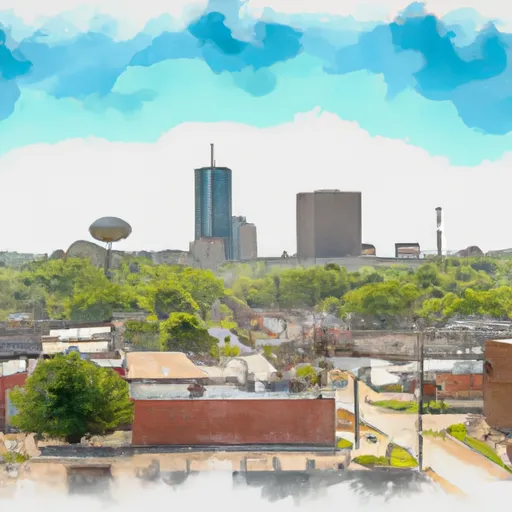-
 Snoflo Premium
Snoflo Premium
Get unlimited access to all our content
With no Ad interruptions! - Start Your Free Trial Login with existing account
Muskogee
Eden Index
Climate
8.3
•
Recreation
4.5
•
Community
2.2
•
Safeguard
5.4/10

Muskogee is a city located in eastern Oklahoma, known for its diverse climate and outdoor recreational opportunities. The city experiences a humid subtropical climate, characterized by hot summers and mild winters. Average summer temperatures range from 90°F (32°C) to 95°F (35°C), with occasional thunderstorms. Winters are generally mild, with average temperatures ranging from 30°F (-1°C) to 50°F (10°C), and occasional snowfall.
The hydrology of Muskogee is influenced by the Arkansas River, which flows through the city. The river provides opportunities for various water-based activities, such as boating, fishing, and water skiing. Additionally, Muskogee is home to several lakes and reservoirs, including Lake Eufaula and Fort Gibson Lake, offering further recreational opportunities like swimming, hiking, and camping.
Outdoor enthusiasts can explore the scenic landscapes of Muskogee through its numerous parks, trails, and golf courses. Honor Heights Park is famous for its stunning botanical gardens, showcasing vibrant flowers and trees. The Three Forks Nature Center offers nature trails where visitors can observe the local wildlife and enjoy birdwatching. Golfers can choose from several well-maintained golf courses, such as Muskogee Country Club and Cobblestone Creek Golf Club.
In conclusion, Muskogee, Oklahoma, offers a diverse climate, influenced by the Arkansas River, providing opportunities for various outdoor recreational activities, including boating, fishing, hiking, and golfing.
What is the Eden Index?
The Snoflo Eden Index serves as a comprehensive rating system for regions, evaluating their desirability through a holistic assessment of climate health, outdoor recreation opportunities, and natural disaster risk, acknowledging the profound impact of these factors on livability and well-being.
Climate Health Indicator (CHI): 8.3
Muskogee receives approximately
1107mm of rain per year,
with humidity levels near 81%
and air temperatures averaging around
16°C.
Muskogee has a plant hardyness factor of
7, meaning
plants and agriculture in this region tend to thrive during the non-winter months.
By considering the ideal temperature range, reliable water supplies, clean air, and stable seasonal rain or snowpacks, the Climate Health Indicator (CHI) underscores the significance of a healthy climate as the foundation for quality living.
A healthy climate is paramount for ensuring a high quality of life and livability in a region, fostering both physical well-being and environmental harmony. This can be characterized by ideal temperatures, reliable access to water supplies, clean air, and consistent seasonal rain or snowpacks.
Weather Forecast
Streamflow Conditions
Robert S. Kerr Reservoir
Area Rivers
Robert S. Kerr Reservoir
Snowpack Depths
Robert S. Kerr Reservoir
Reservoir Storage Capacity
Robert S. Kerr Reservoir
Groundwater Levels
Recreational Opportunity Index (ROI): 4.5
The Recreational Opportunity Index (ROI) recognizes the value of outdoor recreational options, such as parks, hiking trails, camping sites, and fishing spots, while acknowledging that climate plays a pivotal role in ensuring the comfort and consistency of these experiences.
Access to outdoor recreational opportunities, encompassing activities such as parks, hiking, camping, and fishing, is crucial for overall well-being, and the climate plays a pivotal role in enabling and enhancing these experiences, ensuring that individuals can engage in nature-based activities comfortably and consistently.
Camping Areas
| Campground | Campsites | Reservations | Toilets | Showers | Elevation |
|---|---|---|---|---|---|
| Clayton Lake State Park | None | 738 ft | |||
| Hugo Lake - Kiamichi State Park | None | 468 ft | |||
| Pat Mayse East - Pat Mayse Lake | 25 | 504 ft | |||
| Rattan Landing - Hugo Lake | None | 433 ft | |||
| Pat Mayse West - Pat Mayse Lake | 85 | 481 ft | |||
| Virgil Point - Hugo Lake | None | 452 ft | |||
| Raymond Gary State Park | None | 480 ft | |||
| Sanders Cove - Pat Mayse Lake | 90 | 541 ft | |||
| Sardis Cove | None | 688 ft | |||
| Kiamichi Park - Hugo Lake | None | 464 ft |
Nearby Fishing
Catastrophe Safeguard Index (CSI):
The Catastrophe Safeguard Index (CSI) recognizes that natural disaster risk, encompassing floods, fires, hurricanes, and tornadoes, can drastically affect safety and the overall appeal of an area.
The level of natural disaster risk in a region significantly affects safety and the overall livability, with climate change amplifying these risks by potentially increasing the frequency and intensity of events like floods, fires, hurricanes, and tornadoes, thereby posing substantial challenges to community resilience and well-being.
Community Resilience Indicator (CRI): 2.2
The Community Resilience Indicator (CRI) recognizes that education, healthcare, and socioeconomics are crucial to the well-being of a region. The CRI acknowledges the profound impact of these elements on residents' overall quality of life. By evaluating educational resources, healthcare accessibility, and economic inclusivity, the index captures the essential aspects that contribute to a thriving community, fostering resident satisfaction, equity, and social cohesion.

